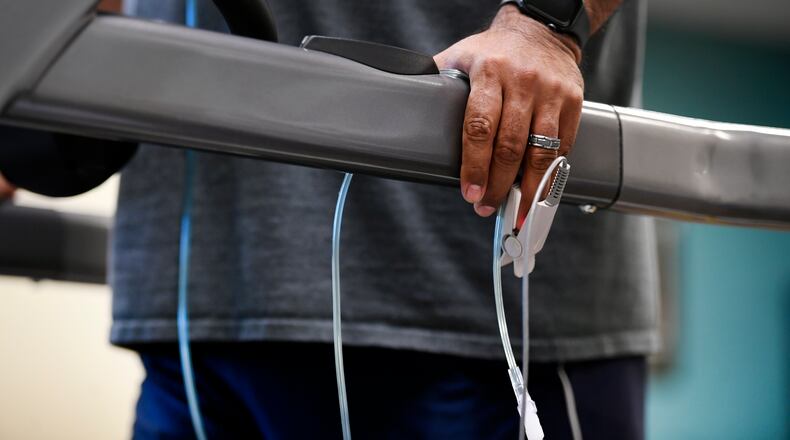Early in the pandemic, when COVID-19 patients were turning up at emergency rooms with dangerously low blood oxygen levels, many people rushed to add pulse oximeters to their home medicine cabinet.
The electronic device, which clips onto a finger to measure heart rate and oxygen saturation level in the blood, could give an early warning of COVID-19. But now the device that hospitals also use to evaluate patients is being called into question by the Food and Drug Administration for errors in readings taken on individuals with darker skin.
The findings of a Journal of the American Medical Association study published on May 31 show that pulse oximeter oxygen level readings were often overestimated for Asian, Black and Hispanic patients in comparison to white patients. This inaccuracy led to the delay of COVID-19 treatment for many.
Dr. James Rogan has experienced firsthand the impact of a flawed pulse oximeter reading. The family physician did not encounter the issue with one of his patients, however. He saw it with his mother.
When Rogan’s mother, Clara Mae Rogan, 88, was admitted to the hospital in his hometown of Gallatin, Tennessee for cardiovascular issues, she received an oxygen reading of 98% from a pulse oximeter — a normal reading.
Rogan was immediately skeptical of the accuracy of the reading because of his mother’s history of chronic illnesses. He said he felt that she needed oxygen from the way she was breathing.
Rogan voiced his concerns to his mother’s cardiologist, who he considers as a family friend. But the physician still did not give his mother oxygen, pointing to the pulse oximeter’s reading.
Only when the cardiologist left for vacation did Rogan find another doctor willing to provide the oxygen treatment. Rogan said that his mother immediately began to feel better. However, she is still recovering today.
“It is something that I think needs to be looked at intently, and evaluated by the companies that make pulse oximeters,” said Rogan, who practices in Atlanta. “Why is it not functioning right?”
A pulse oximeter works by using a beam of light to detect oxygen carried in red blood cells after being attached to the tip of the finger or ear. It provides a reading of the oxygen saturation level, usually presented as a percentage, and a pulse rate. Oxygen saturation values are between 95% and 100% for most healthy people. Besides skin pigment, poor circulation, cold skin and nail polish can interfere with the accuracy of readings.
In the early stages of the pandemic, health officials advised people to buy over-the-counter pulse oximeter machines to monitor their oxygen levels without having to go to a healthcare facility.
Following an earlier study that was published in The New England Journal of Medicine in December 2020, the FDA issued a safety communication in February 2021 cautioning against relying on pulse oximetry alone to determine oxygen levels.
On June 22 the FDA announced plans for a public meeting of the Medical Devices Advisory Committee to address concerns about the accuracy of pulse oximeters for darker skinned patients.
Dr. Eddie Richardson Jr., owner of Lake Oconee Primary and Urgent Care Center and a hospitalist at Putnam General Hospital, both in Eatonton, feels confident that he used the sometimes necessary follow-ups to pulse oximetry with the more than 250 coronavirus patients that he has seen throughout the pandemic.
“In my clinical practice, I would say that I probably picked up some discrepancies. But, as I was thinking through it, being that O² (oxygen) wasn’t our only indicator, we looked at CT scans, chest x-rays and tests and made clinical decisions based upon that,” he said.
However, Richardson keeps in mind the “domino effect” that a disparity like the one found in pulse oximetry can have in healthcare.
“If you are not looking for it, then you’re not going to find it. If you don’t know these biases are out there, then you are not going to be sensitive to them,” Richardson explained. “It just further highlights the racial and ethnic disparities that our healthcare system has and the bias of how we treat patients in general.”
One alternative to pulse oximeters is an arterial blood gas (ABG) test, considered the “gold standard” in determining oxygen levels. But they require a painful blood draw and additional equipment, processing, time and money.
Due to their availability and affordable cost, pulse oximeters “are fantastic for giving us a very good idea of where our patients’ oxygen saturation levels are,” said Dr. Cecil Bennett, a family physician at Newnan Family Medicine Associates and adjunct professor at Morehouse School of Medicine. “This is really a relevant study that shows that even if everything is done correctly, the calibration of the pulse oximeter may not be the best for people of color.”
Doctors say that the implications of incorrect pulse oximeter readings in Georgia are broad, especially among Black people.
“In parts of the country where there are high minority concentrations, these things matter. African Americans have a greater likelihood of being underdiagnosed across the board,” Bennett said. “This is just another situation that we find ourselves in where we’re depending on a device to give us accurate readings and we’re finding out years down the road after the beginning of COVID that the device isn’t as accurate as we would like in African Americans.”
When Dr. Bonzo Reddick, chair of the Department of Community Medicine at Mercer University School of Medicine spoke with The Atlanta Journal-Constitution, he thought of the Black and brown coronavirus patients that were sent home but returned to the hospital in worse condition.
“I have had some patients who were sent home because they were thought to be well enough to be treated at home, and they ended up getting readmitted to the hospital later on,” Reddick recalled. “It made me wonder were their oxygen levels really normal the first time they were evaluated or not.”
For other doctors, the race-based focus of the report shows a missed opportunity within an important study.
Dr. Camara Phyllis Jones is a family physician, epidemiologist and adjunct professor at the Rollins School of Public Health at Emory University and Morehouse School of Medicine who has devoted much of her work to combating racism in medicine and at large.
Jones noted the original study was based on patients’ self-described race rather than their actual skin tones — a more variable measurement that would apply to more people.
“They (researchers) didn’t have skin tone, which would have been the perfect measure in terms of really understanding the faults in pulse oximetry and how we are using it now,” Jones observed. “They have identified an important problem and all they had was self-identified “race” as a proxy for a group of skin tones…. This is about light absorption, so it has to do with skin tone.”
She said the study’s focus on race fails to capture the biology surrounding the oximetry problem. “We have to abandon our notion of ‘race’ as something that is biological,” she said.
Jones, like many other doctors, feels as though something should be done on a foundational level about the issue found in pulse oximeters.
“Structural racism often shows up as lack of action in the face of need,” Jones remarked. “Now, we had better see the manufacturers of pulse oximeters trying to address this issue that they have known about since the New England Journal paper in 2020.”
How to Use a Pulse Oximeter
• When placing the oximeter on your finger, make sure your hand is warm, relaxed, and held below the level of the heart. Remove any fingernail polish on that finger.
• Sit still and do not move the part of your body where the pulse oximeter is located.
• Wait a few seconds until the reading stops changing and displays one steady number. Oxygen saturation values are between 95% and 100% for most healthy individuals, but sometimes can be lower in people with lung problems.
• Pay attention to whether the oxygen level is lower than earlier measurements, or is decreasing over time. Changes or trends in measurements may be more meaningful than one single measurement.
The Atlanta Journal-Constitution and Report for America are partnering to add more journalists to cover topics important to our community. Please help us fund this important work at ajc.com/give
About the Author
Keep Reading
The Latest
Featured




